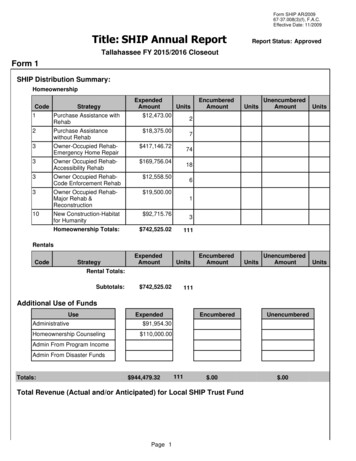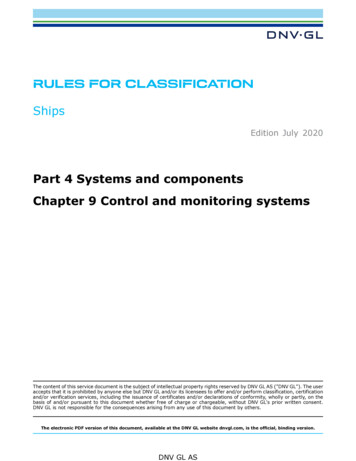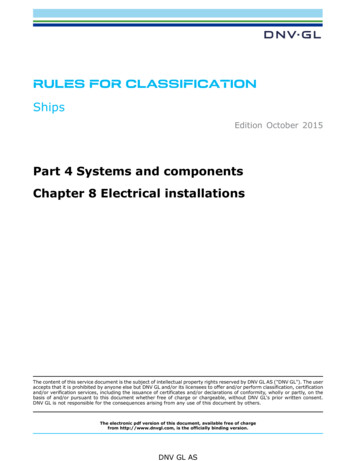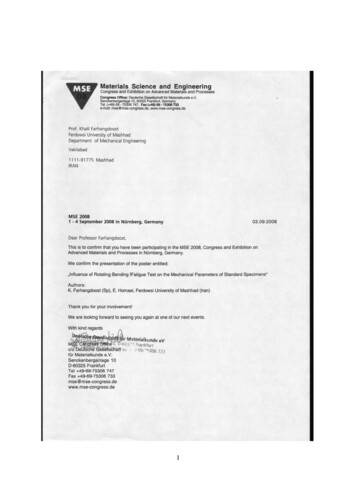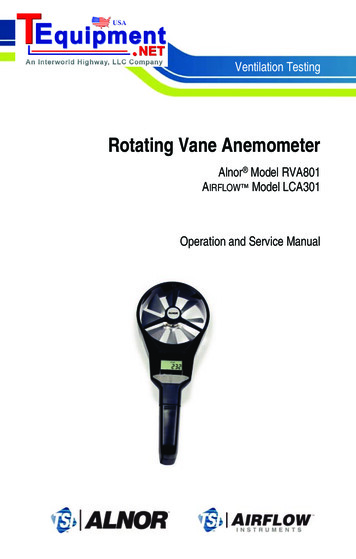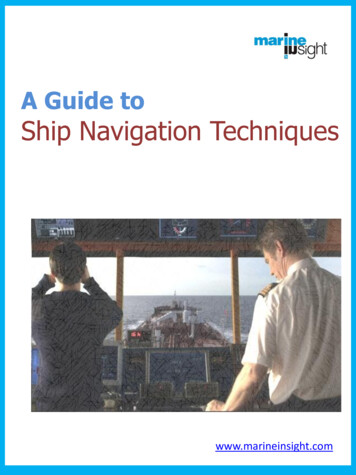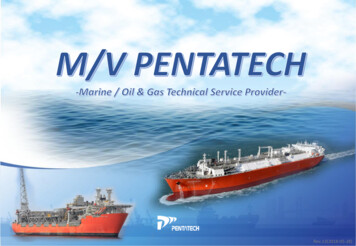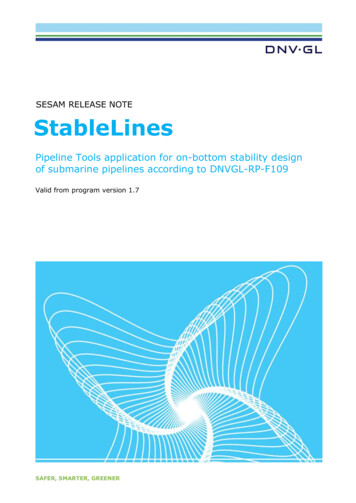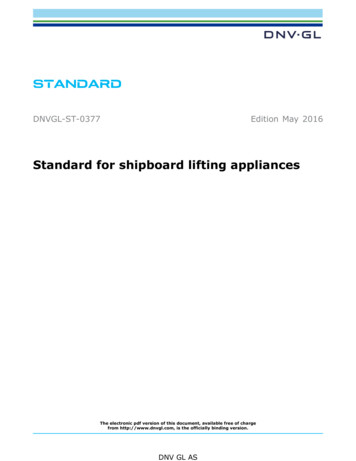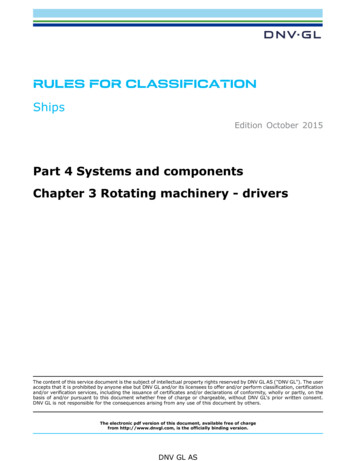
Transcription
RULES FOR CLASSIFICATIONShipsEdition October 2015Part 4 Systems and componentsChapter 3 Rotating machinery - driversThe content of this service document is the subject of intellectual property rights reserved by DNV GL AS ("DNV GL"). The useraccepts that it is prohibited by anyone else but DNV GL and/or its licensees to offer and/or perform classification, certificationand/or verification services, including the issuance of certificates and/or declarations of conformity, wholly or partly, on thebasis of and/or pursuant to this document whether free of charge or chargeable, without DNV GL's prior written consent.DNV GL is not responsible for the consequences arising from any use of this document by others.The electronic pdf version of this document, available free of chargefrom http://www.dnvgl.com, is the officially binding version.DNV GL AS
FOREWORDDNV GL rules for classification contain procedural and technical requirements related to obtainingand retaining a class certificate. The rules represent all requirements adopted by the Society asbasis for classification. DNV GL AS October 2015Any comments may be sent by e-mail to rules@dnvgl.comIf any person suffers loss or damage which is proved to have been caused by any negligent act or omission of DNV GL, then DNV GL shallpay compensation to such person for his proved direct loss or damage. However, the compensation shall not exceed an amount equal to tentimes the fee charged for the service in question, provided that the maximum compensation shall never exceed USD 2 million.In this provision "DNV GL" shall mean DNV GL AS, its direct and indirect owners as well as all its affiliates, subsidiaries, directors, officers,employees, agents and any other acting on behalf of DNV GL.
Part 4 Chapter 3 Changes - currentCHANGES – CURRENTThis is a new document.The rules enter into force 1 January 2016.Rules for classification: Ships — DNVGL-RU-SHIP-Pt4Ch3. Edition October 2015Rotating machinery - driversDNV GL ASPage 3
Changes – current. 3Section 1 Reciprocating internal combustion engines. 81 General. 81.1 Application. 81.2 Documentation of the engine. 101.3 Drawing particulars.141.4 Documentation of arrangement. 151.5 Documentation of vibration.152 Design.152.1 General. 152.2 Approved materials.162.3 Safety valves and crankcase ventilation. 172.4 Turning appliances and interlocking device.192.5 Crankshaft calculation. 192.6 Fire protection and general requirements to piping systems fitted on theengine.202.7 Hydraulic oil system. 212.8 Fuel oil system. 212.9 Fuel gas system.222.10 Charge air system, blowers and cooler. 222.11 Starting equipment. 232.12 Lubrication oil system. 232.13 Cooling system.242.14 Type approval testing.242.15 Type testing data collection. 242.16 Type testing program. 253 Testing and Inspection. 293.1 Recognition of engine manufacturer’s workshops. 293.2 Manufacturing inspections. 303.3 Testing of materials and components. 303.4 Inspection during assembly. 344 Workshop testing. 354.1 Application.354.2 General engine tests.354.3 Testing of propulsion engines.36Rules for classification: Ships — DNVGL-RU-SHIP-Pt4Ch3. Edition October 2015Rotating machinery - driversDNV GL ASPage 4Part 4 Chapter 3 ContentsCONTENTS
4.5 Survey after testing.375 Control and Monitoring. 385.1 General. 385.2 Speed governing. 395.3 Overspeed protection. 395.4 Propulsion engines.405.5 Auxiliary engines. 445.6 Emergency engines. 475.7 Oil mist detection/monitoring and alarm system (Oil mist detector). 496 Arrangement. 506.1 Engine Alignment/Seating.506.2 Accessibility of engines. 506.3 Earthing. 506.4 Starting with compressed air. 506.5 Electrical starting equipment.516.6 Exhaust pipes. 516.7 Lubrication and fuel oil systems. 516.8 Crankcase ventilation pipes. 517 Vibration. 517.1 Torsional and axial vibration. 518 Installation Inspections. 518.1 Engine Seating.528.2 Engine alignment. 529 Shipboard Testing.529.1 Shipboard trials (dock and sea trials). 529.2 General engine tests.529.3 Testing of propulsion engines.539.4 Testing of engines driving auxiliaries and electrical generators. 549.5 Engine vibration. 549.6 Opening up after testing. 5410 Gas only and dual fuel engines.5410.1 Scope and application. 5410.2 General requirements.5410.3 Engine control-, monitoring-, alarm-, and safety systems.5810.4 Tests. 6110.5 Retrofit. 6211 Auxiliary equipment and components. 6211.1 Turbochargers. 62Rules for classification: Ships — DNVGL-RU-SHIP-Pt4Ch3. Edition October 2015Rotating machinery - driversDNV GL ASPage 5Part 4 Chapter 3 Contents4.4 Auxiliary driving engines and engines driving electrical generators. 37
11.3 Axial vibration dampers.7011.4 Explosion relief valves. 70Section 2 Gas Turbines.721 General. 721.1 Application.721.2 Definitions. 721.3 Certification. 731.4 Documentation requirements - Manufacturer.741.5 Documentation requirements – Builder.772 Design and Construction.792.1 General. 792.2 Component design requirements – manufacturer. 802.3 Systems Design requirements - package provider / builder. 822.4 Enclosure, Fire Safety. 863 Control and Monitoring. 873.1 Gas Turbine Control. 873.2 Monitoring and instrumentation system. 903.3 Auxiliary system controls.903.4 Control stations.904 Arrangement. 914.1 Alignment and reaction forces.914.2 Mounting in general.914.3 Rigid mounting. 924.4 Resilient mounting.925 System vibration.935.1 General. 935.2 Documentation of vibration analysis.935.3 gas turbine vibration. 946 Tests and trials.946.1 Tests, General. 946.2 Material tests.966.3 Tests on components (manufacturer’s works).966.4 Type approval test (manufacturer’s works). 976.5 Type testing program.986.6 Inspection of condition of parts (Borescope / tear down).1016.7 Certification testing (FAT, manufacturer’s works). 1016.8 Certification test program. 102Rules for classification: Ships — DNVGL-RU-SHIP-Pt4Ch3. Edition October 2015Rotating machinery - driversDNV GL ASPage 6Part 4 Chapter 3 Contents11.2 Torsional vibration dampers. 69
6.10 Shipboard trials. 103Section 3 Steam Turbines.1061 General. 1061.1 Application. 1061.2 Certification requirements. 1061.3 Documentation requirements - Manufacturer. 1061.4 Documentation requirements - Builder. 1072 Design.1072.1 General. 1072.2 Component design requirements. 1083 Inspection and testing.1083.1 General. 1084 Workshop testing.1094.1 General turbine tests. 1095 Control and monitoring.1105.1 General. 1105.2 Speed governing. 1105.3 Safety functions and devices.1105.4 Monitoring. 1116 Arrangement. 1136.1 General arrangement. 1136.2 Arrangement of propulsion machinery. 1137 Vibrations. 1147.1 Torsional vibrations. 1148 Installation inspections. 1148.1 General. 1149 Shipboard testing. 1159.1 General. 1159.2 Auxiliary turbines.1159.3 Propulsion turbines. 115Rules for classification: Ships — DNVGL-RU-SHIP-Pt4Ch3. Edition October 2015Rotating machinery - driversDNV GL ASPage 7Part 4 Chapter 3 Contents6.9 Inspection of condition of parts (Borescope).103
1 General1.1 Application1.1.1 The requirements in this section apply to reciprocating internal combustion engines used for thefunctions listed in Ch.2 Sec.1 [1.1].The engines are subject to approval, installation survey and shipboard testing1.1.2 For the purpose of these requirements, reciprocating internal combustion engines are:— diesel engines, fuelled with liquid fuel oil— dual-fuel engines, fuelled with liquid fuel oil and/or with gaseous fuel— gas-only engines, fuelled with gaseous fuel only and ignited by either a spark or micropilot of liquid fuel oil"Reciprocating internal combustion engine"in this section is referred to as "engine".1.1.3 For diesel engines with power less than 300 kW, the requirements in this section are limited to:— insulation of hot surfaces, see [2.6]— jacketing of high-pressure fuel oil lines and screening of pipe connections in piping containing flammableliquids, see [2.6] and [2.8]— requirements for type testing as given in [2.14.2]— requirements for workshop testing as given in [4.1.6]— requirements for control and monitoring according to [5.6], but shut down due to low lube oil pressureaccording to Table 10and Table 11 to be provided.— requirements for shipboard testing as given in [9]For dual-fuel and gas-only engines additional requirements in [10] applies.1.1.4 Type TestingEngines shall be Type Tested according to requirements stated in this section.For more information regarding the Society's Type Approval scheme, see DNVGL-CG-0338.1.1.5 For diesel engines intended for other purposes than those listed in [1.1.1], only the requirements givenby IMO, referred to as the two first bullets in [1.1.3] have to be fulfilled.1.1.6 In case of engines intended for vessels approved for unmanned machinery installations (ClassNotation E0),Pt.6 Ch.2 Sec.2 applies in addition to the requirements in this section.1.1.7 For all engine installations intended for running on crude oil or gas, additional requirements are givenin Pt.6 Ch.2 Sec.5 and Pt.6 Ch.2 Sec.6.1.1.8 Regarding the use of marine fuels with a sulphur content not exceeding 0.1% m/m and minimumviscosity of 2 cSt the engine manufacturer’s recommendations with respect to e.g. fuel change-over process,lubricity, viscosity and compatibility shall be described in the operation manual.1.1.9 The rules in [2] to [5] apply to the engine, its components and its internal systems. The rules in [6] to[9] apply to the installation of the engine, the engine and its system dynamics, which are influenced by theengine, and the shipboard testing.Rules for classification: Ships — DNVGL-RU-SHIP-Pt4Ch3. Edition October 2015Rotating machinery - driversDNV GL ASPage 8Part 4 Chapter 3 Section 1SECTION 1 RECIPROCATING INTERNAL COMBUSTION ENGINES
For engines with rated power less than 300 kW, the product certification need only be based on the applicableelements of design approval in [2] and workshop testing in [4] and [10] . For dual-fuel and gas-only engines,see [1.1.2].The requirement for product certification may be waived for diesel engines with rated power less than 300kW when the engine is type approved.Table 1 Certification requiredObjectCertificate typeIssued byEnginePCSocietyCertification standard*Additional description*Unless otherwise specified the certification standard is the Society's RulesFor general certification requirements see Pt.1 Ch.3 Sec.4.For a definition of the certification types see Pt.1 Ch.3 Sec.5.1.1.11 Engines manufactured under licenseFor each engine type manufactured under licence, the licensee shall submit the following documents forapproval:— comparison of all the drawings and documents as per Table 2, where applicable, indicating the relevantdrawings used by the licensee and the licensor— all drawings of modified components, if available, as per Table 2 together with the licensor's declaration ofconsent to the modifications— a complete set of drawings or list of approved drawing shall be put at the disposal of the local inspectionoffice of the Society as a basis for the performance of tests and inspections.1.1.12 Definition of engine typeThe type specification of an engine is defined by the following rer's type designationcylinder borestrokemethod of injection (direct, indirect)valve and injection operation (by cams or electronically controlled)fuels which can be used (liquid, dual-fuel, gaseous)working cycle (4-stroke, 2-stroke)method of gas exchange (naturally aspirated or supercharged)rated power per cylinder at rated speed as well as mean effective pressure, see [2.1.6]method of pressure charging (pulsating pressure system or constant-pressure charging system)charge air cooling system (with or without intercooler, number of stages)cylinder arrangement (in-line, vee).1.1.13 Engines driving generators in electric propulsion systems shall be equipped with sensors andmonitored as propulsion engines (Table 10) and with safety actions according to Table 11.Rules for classification: Ships — DNVGL-RU-SHIP-Pt4Ch3. Edition October 2015Rotating machinery - driversDNV GL ASPage 9Part 4 Chapter 3 Section 11.1.10 Certification requirementsEngines shall be delivered with a product certificate according to Table 1 that is based on the applicableelements of design approval in [2], testing and inspection in [3] and the workshop testing in [4].
1.2.1 GeneralDrawings, data, specifications, calculations and other information shall be submitted as applicable accordingto Table 2, Table 3 and Table 4, except for items covered by a valid type approval.1.2.2 Design modificationsFollowing initial approval of an engine type by the Society, only those documents listed in Table 2 to Table 4which embodies design modifications shall be resubmitted for approval.1.2.3 Approval of engine componentsThe manufacturers shall request approval from the Society for exhaust gas turbochargers, torsional vibrationdampers, crankcase relief valves etc, see [11] for more information. For oil mist detectors see [5.7].Table 2 Documentation of engine fuelled by liquid fuel oilObjectEngineDocumentation typeAdditional descriptionInfoZ110 – Data sheetData required on the Society forms ENG 901 andENG 911FIC020 – Assembly or arrangementdrawingTransverse cross-sectionFIC020 – Assembly or arrangementdrawingLongitudinal sectionFIM010 - Material specification, metalsMain parts with information on non-destructive1)material tests and pressure tests [2.2]APC020 – Assembly or arrangementdrawingArrangement of foundation (for main enginesonly) [1.4]Z163 – Maintenance manual2)FIZ161 – Operation manual2)FI1)1)1)1)FI1)1)1)Z252 - Test procedure at manufacturer Type Approval Test program [2.14] to [2.16]APZ262 - Report from test atmanufacturerType Approval Test report [2.14] to [2.16]APC040 – Design analysisDocumentation of vibration, mass elastic dataand excitation values [1.5],Ch.2 Sec.3FIBedplateC030 – Detailed drawingBedplate and crankcase/engine block [2.2]if3)cast, for information onlyAPInternal thrustbearingC020 – Assembly or arrangementdrawingIncluding thrust bearing bedplateFrame box andcolumnC030 – Detailed drawingIf cast, for information onlyAPTie rodsC030 – Detailed drawing6)FICylinder headsC020 – Assembly or arrangementdrawingFICylinder linersC030 – Detailed drawingFI4)1)1)1)1)FI1)1)1)1)Rules for classification: Ships — DNVGL-RU-SHIP-Pt4Ch3. Edition October 2015Rotating machinery - driversDNV GL ASPage 10Part 4 Chapter 3 Section 11.2 Documentation of the engine
Documentation typeAdditional descriptionInfoC030 – Detailed drawingCrankshaft for each number of cylinders[2.5.1]to [2.5.9]APC030 – Detailed drawingCrankshaft assembly for each number ofcylinders [2.5.1] to [2.5.9]APC030 – Detailed drawingShaft coupling bolts [1.3.2], [2.5]APShaftC030 – Detailed drawingThrust shaft of intermediate shaftAPCrankshaft counterweightC020 – Assembly or arrangementdrawingIncluding fastening boltsCrankshaftSingle Engine mountedsystemsControl andmonitoring systemExhaust systemShielding ofpiping containingflammable liquidsC030 – Detailed drawingC020 – Assembly or arrangementdrawingC020 – Assembly or arrangementdrawingC020 – Assembly or arrangementdrawingC020 – Assembly or Piston rod assembly7)1)FI6) 7)FI1)C020 – Assembly or arrangementdrawingCamshaft and high pressure pump driveFIS010 – Piping diagram (PD)Starting air systemS010 – Piping diagram (PD)Fuel oil systemS010 – Piping diagram (PD)Lubrication oil system[1.3.5],[2.12]S010 – Piping diagram (PD)Cooling water system[1.3.5],[2.13]S010 – Piping diagram (PD)Hydraulic system for valve lift [1.3.5],[2.7]APC020 – Assembly or arrangementdrawingExhaust and charge air system8)[1.3.2],[2.10.2]API200 - Control and monitoring systemdocumentationEngine control and safety system including listof set points of required alarms and shutdowns4) 8)[5]API200 - Control and monitoring systemdocumentationElectronic components and systemsC020 – Assembly or arrangementdrawingShielding and insulation [2.6.1]FIC020 – Assembly or arrangementdrawingShielding of high pressure fuel pipes [2.8.6]APC020 – Assembly or arrangementdrawingHigh pressure parts for fuel oil injection 1)[1.3.5],[2.8]AP8)1)AP8)1)FI8)Rules for classification: Ships — DNVGL-RU-SHIP-Pt4Ch3. Edition October 2015Rotating machinery - driversDNV GL AS1)1)1)12)[5]1)1)AP1)1)1)Page 11Part 4 Chapter 3 Section 1Object
Documentation typeAdditional descriptionInfoCrankcase safetyvalveC020 – Assembly or arrangementdrawingCrankcase explosion relief valves[1.3.1],[2.3]APFire and gasdetection and alarmsystemsC020 – Assembly or arrangementdrawingOil mist detection, monitoring and alarm system11)[5.7]AP9)1)1)1) Covered by Type approvalAP For approval; FI for informationTable 3 Additional documentation for gas fuelled engines, see [10].ObjectEngineEngine mountedsystemsFuel systemExhaust systemDocumentation typeAdditional descriptionInfoZ060 – Functional descriptionFunctional description of gas fuelled engine[10.2]FIZ071 - Failure mode and effectanalysis (FMEA)Engine safety concept, including system FMEAwith regard to gas as fuel [10.3.3]FII200 – Control and monitoring systemdocumentationIgnition system, schematic layout, functional8)description, specification [10.2.13]AP1)I200 – Control and monitoring systemdocumentationCombustion monitoring system, schematic8)layout, functional description, specificationAP1)I200 – Control and monitoring systemdocumentationElectronic components of engine control-,ignition-, alarm-, safety-, monitoring system,etc. (specification) [10.2.14]AP1)I070 – Instrument and equipment listList of approved and certified equipment[10.2.14]FIS010 – Piping diagram (PD)Fuel gas system for the engine, including doublewall piping system and ventilation system8)(schematic layout) [10.2.12]AP1)Z265 – Calculation reportCharge air system, documentation of sufficientstrength if relief valve is not installedarrangement [10.2.5]AP1)C020 – Assembly or arrangementdrawingCharge air system relief valve arrangement ifinstalled [10.2.5]AP1)S010 - Piping diagram (PD)Ventilation system (schematic layout)for thefuel gas system for the engine [10.2.12]AP1)Z252 - Test procedure atmanufacturerTesting procedure for gas tightness [10.4]FIC030 – Detailed drawingFuel gas double wall piping and flange designAP1)Z265 – Calculation reportEngine exhaust gas system, documentation ofsufficient strength if relief valve is not installedarrangement [10.2.5]AP1)8)1)1)1)C020 – Assembly or arrangementdrawingRules for classification: Ships — DNVGL-RU-SHIP-Pt4Ch3. Edition October 2015Rotating machinery - driversDNV GL AS1)Page 12Part 4 Chapter 3 Section 1Object
Fire and gasdetection and alarmsystemsExplosion (Ex)protectionDocumentation typeAdditional descriptionInfoS010 - Piping diagram (PD)Engine exhaust gas system relief valvearrangement if installed [10.2.5]AP1)I200 – Control and monitoring systemdocumentationGas detection system for the engine, schematic8)layout, functional description [10.3.2]AP1)Z252 - Test procedure atmanufacturerTesting procedure for gas detection system[10.4]FIE090 – Table of Ex-installationList of explosion-proof electrical equipmentincl. specification of certifications [10.2.14]For documentation of electrical equipment inhazardous areas please refer to Ch.8AP1)1)1) Covered by Type approvalAP For approval; FI for informationTable 4 Additional documentation for auxiliary equipment and components, see [11].ObjectDocumentation typeTurbochargerC020 – Assembly or arrangementdrawingTorsional vibrationdamperC020 – Assembly or arrangementdrawingAxial vibrationdamperEngineAdditional descriptionInfo13)AP1)[11.2]AP1)C020 – Assembly or arrangementdrawing[11.3]FII200 - Control and monitoring systemdocumentationAlarm and monitoringAPI200 - Control and monitoring systemdocumentationSafety SystemAPI200 - Control and monitoring systemdocumentationSpeed control / governor / including ignition(for gas fuelled en
—diesel engines, fuelled with liquid fuel oil —dual-fuel engines, fuelled with liquid fuel oil and/or with gaseous fuel —gas-only engines, fuelled with gaseous fuel only and ignited by either a spark or micropilot of liquid fuel oil "Reciprocating internal combustion engine"in this section is referred to as "engine".

